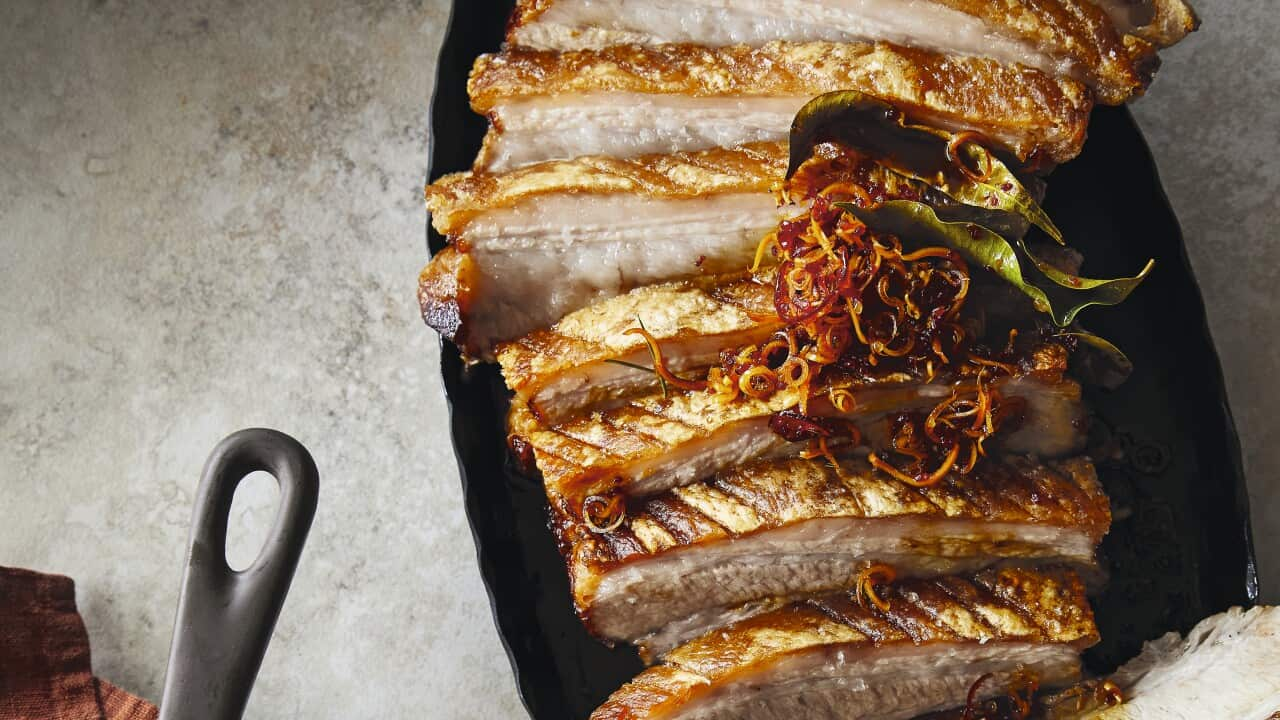serves
4-6
prep
10 minutes
cook
1:50 hour
difficulty
Mid
serves
4-6
people
preparation
10
minutes
cooking
1:50
hour
difficulty
Mid
level
Ingredients
- 1.2 kg pork belly, off the bone
- 2 tbsp salt flakes
Native citrus caramel
- 4 coriander roots, scraped
- 6 cm piece of native ginger, roughly chopped
- 2 cm piece of fresh turmeric, roughly chopped, or ½ tsp ground turmeric
- 4 tbsp macadamia oil
- 100 g light palm sugar
- 400 ml orange juice
- 1 lemongrass stalk, thinly sliced
- 4 – 6 anise myrtle leaves
- 3 lemon myrtle leaves
- 4 tsp Geraldton wax
- 100 ml lime juice
- pulp of 8 finger limes
Resting time: overnight + 15 minutes
Instructions
- Remove the pork from its packaging and dry thoroughly with paper towel. Score the skin of the pork and, for best results, allow it to dry, uncovered, in the fridge overnight.
- When you’re ready to cook the pork, preheat the oven to 240°C/ 220°C fan-forced.
- Season the pork belly generously with the salt flakes, rubbing it into the scored skin. Place the meat on a trivet in a roasting tin and cook for 40 minutes until the skin has crackled.
- Reduce the oven temperature to 200°C/ 180°C fan-forced, and cook for 1 hour or until the meat is cooked through and the juices run clear. Leave to rest for 15 minutes before carving.
- To make the native citrus caramel, pound the coriander, ginger and turmeric to a fine paste using a pestle and mortar, or blend in a small food processor. Heat the oil in a small heavy-based frying pan over medium heat and fry the paste, stirring constantly, until it is just starting to colour. Stir in the sugar and 2 ½ tbsp of water and cook until the sugar dissolves. Add the orange juice, lemongrass and all the myrtle leaves and bring to the boil, then turn down to a simmer and slowly reduce to a syrup consistency. Pour the caramel into a jug and allow to cool before stirring through the Geraldton wax, lime juice and finger lime pearls.
- Carve the pork into thick slices and arrange on a platter, then pour the native citrus caramel over the sliced pork and serve.
Note
- This really shines with native flavours – but if any are tricky to find, more accessible alternatives can also do the trick. Consider finely shredded makrut lime leaf in place of the Geraldton wax; 2 teaspoons of fennel seeds in place of the anise myrtle; and the zest of 1 lemon in place of the lemon myrtle. The finished dish will be a close runner-up to the real deal.
Cook's Notes
Oven temperatures are for conventional; if using fan-forced (convection), reduce the temperature by 20˚C. | We use Australian tablespoons and cups: 1 teaspoon equals 5 ml; 1 tablespoon equals 20 ml; 1 cup equals 250 ml. | All herbs are fresh (unless specified) and cups are lightly packed. | All vegetables are medium size and peeled, unless specified. | All eggs are 55-60 g, unless specified.

